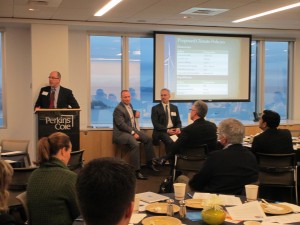By Benjamin Romano, Originally published on Xconomy
 Washington Gov. Jay Inslee got Republicans and Democrats to talk in 2013 about proposals to meet the state’s carbon emissions reduction goals. Expect more talk, but little action in 2014.
Washington Gov. Jay Inslee got Republicans and Democrats to talk in 2013 about proposals to meet the state’s carbon emissions reduction goals. Expect more talk, but little action in 2014.
Olympia watchers do see prospects for movement on a few smaller issues important to the Washington clean technology and energy sectors, and technology companies broadly. But not when it comes to the big policies—cap-and-trade, a low-carbon fuels standard, or a carbon tax—that would put the state on the global map, and on course to meet its target of reducing greenhouse gas emissions to 1990 levels by 2020.
“I do not believe that any of those things will move forward in the next 12 months,” Brad Boswell, a political consultant and lobbyist, told theWashington Clean Technology Alliance at a meeting Wednesday morning in Seattle.
In December, at the opening of the Clean Energy Institute at the University of Washington, Inslee reaffirmed his commitment to putting a price on carbon emissions. “Inaction is not an option,” he said.
The next day, Republicans and Democrats, led by Inslee, delivered proposals at a hearing of the Climate Legislative and Executive Workgroup (CLEW), created through the governor’s signature 2013 legislative achievement on climate and clean energy. A subsequent meeting was cancelled because of “on-going discussions.”
 Todd Myers, environmental director at the Washington Policy Center, analyzed the CLEW policy proposals based on estimated costs to reduce one ton of carbon dioxide emissions.
Todd Myers, environmental director at the Washington Policy Center, analyzed the CLEW policy proposals based on estimated costs to reduce one ton of carbon dioxide emissions.
“The Democrats’ costs are very high and very uncertain,” he said at the WCTA meeting. “Republican costs are very low, but they’re much less ambitious.”
Neither side proposed what Myers sees as the most straightforward and flexible means of carbon emissions reductions: a revenue-neutral carbon tax was not among the proposals from either party. Under this policy, all carbon emissions in the state would be taxed at a set rate—in British Columbia, for example, it’s $30 a ton—but cuts in B&O or sales taxes would be implemented to offset the impact to businesses and consumers.
He says the tax allows individuals to adjust in their own ways. Those who want to reduce their tax payments could do it through telecommuting, for example. It would also be a strong incentive for low- or no-carbon energy technology innovation and deployment. And best of all, it brings with it a glimmer of political possibility, at least in part because it’s not the first choice of either side.
Democrats and environmentalists want the certainty of a cap-and-trade policy, which would put a defined limit on state emissions. Republicans and business interests want nothing, he says.
Boswell agrees, saying a cap-and-trade policy would “single-handedly coalesce the entire industrial sector” against it. A revenue-neutral carbon tax is “by far the most politically viable carbon policy,” he says.
The Democrats’ draft proposal to the CLEW (6-page PDF) leads off with a “cap and market” program. It also includes recommendations to end the import of electricity from coal-fired power plants; new incentives and financing programs for energy efficient buildings; financing for clean energy research, development, and deployment; and climate-conscious transportation measures.
There is no mention of a carbon tax. But Richard Locke, executive director of the Washington Department of Commerce Office of Economic Development and Competitiveness, says, “I think the governor has a wide open door on a carbon tax.”
He also pointed out that the Republicans provided ” a pretty short list” of proposals to the CLEW.
These include allowing efficiency upgrades to Bonneville Power Administration hydroelectric dams to count as eligible renewable resources; greater energy conservation; and the study of advanced nuclear power generation (16-page PDF).
Locke also touted Inslee’s 2013 achievements, including a $40 million clean energy fund, which will be used this year on initiatives including a revolving loan program—in partnership with community financial institutions—for energy efficiency improvements in residential and commercial buildings, and battery energy storage projects to help manage electricity demand peaks.
He says Inslee will ask the legislature this year for measures to address the largest source of carbon emissions in Washington: transportation. These include $5 million to help establish an east-west corridor of electric vehicle charging stations, and $7.5 million to help local governments and ports buy electric vehicles for their fleets.
Meanwhile, Boswell offers his predictions for what lawmakers might actually do in the two-month session that begins Jan. 13:
The state’s high-technology tax credit, for one, is expected to get attention. The law, enacted in 2004, gives companies a credit against their business and occupation taxes for research and development work in fields including advanced materials, biotechnology, and environmental technology. It is scheduled to expire Jan. 1, 2015.
Boswell also expects attention for state solar incentives. And, he adds, there will likely be the perennial tinkering with the state’s voter-approved renewable energy mandate for utilities. “If history is any indication, very little will happen,” he says.